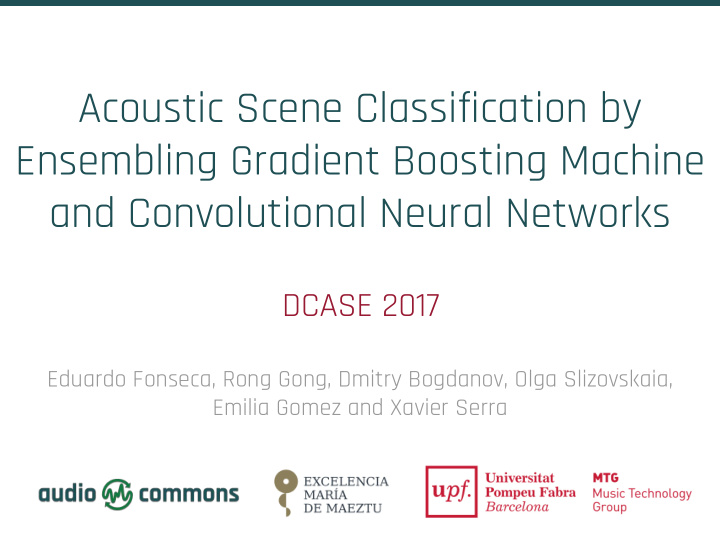



Acoustic Scene Classification by Ensembling Gradient Boosting Machine and Convolutional Neural Networks DCASE 2017 Eduardo Fonseca, Rong Gong, Dmitry Bogdanov, Olga Slizovskaia, Emilia Gomez and Xavier Serra
Outline Introduction ● Proposed System & Results ● Summary ● 2 2
Introduction Acoustic Scene Classification (ASC) ● 15 acoustic scenes ⇀ system recording environment 3
Introduction Traditionally: feature engineering ● feature extraction ⇀ classifier ⇀ 4
Introduction Traditionally: feature engineering Nowadays: data-driven ● ● feature extraction learning representations ⇀ ⇀ classifier ⇀ 5
Introduction Traditionally: feature engineering Nowadays: data-driven ● ● feature extraction learning representations ⇀ ⇀ classifier ⇀ How about combining both approaches for ASC ? 6
Proposed System Freesound score GBM splitting Extractor aggregation acoustic late scene fusion 10s segment pre- score CNN splitting processing aggregation mel-spectrogram 7
Gradient Boosting Machine audio feature snippets vectors acoustic Freesound score n n GBM n splitting scene Extractor aggregation Freesound Extractor by ● http://essentia.upf.edu/documentation/freesound_extractor.html ● 8
Gradient Boosting Machine audio feature snippets vectors acoustic Freesound score n n GBM n splitting scene Extractor aggregation Gradient Boosting Machine: ● effective in Kaggle ⇀ multiple weak learners (decision trees) ⇀ 9
Gradient Boosting Machine audio feature snippets vectors acoustic Freesound score n n GBM n splitting scene Extractor aggregation Gradient Boosting Machine: ● effective in Kaggle ⇀ multiple weak learners (decision trees) ⇀ added iteratively ⇀ Implementation: ● LigthGBM https://github.com/Microsoft/LightGBM ⇀ 10
Gradient Boosting Machine audio feature snippets vectors acoustic Freesound score n n GBM n splitting scene Extractor aggregation Score aggregation: ● averaging scores across snippets ⇀ argmax ⇀ Results: ● development set ⇀ 4-fold cross-validation provided ⇀ Accuracy: 80.8% ⇀ 11
Convolutional Neural Network log-scaled T-F mel-spectrogram patches acoustic pre- score n CNN n splitting scene processing aggregation log-scaled mel-spectrogram ● 128 bands ⇀ 12
Convolutional Neural Network log-scaled T-F mel-spectrogram patches acoustic pre- score n CNN n splitting scene processing aggregation log-scaled mel-spectrogram ● 128 bands ⇀ Time splitting: ● T-F patches 1.5s ⇀ 13
Convolutional Neural Network log-scaled T-F mel-spectrogram patches acoustic pre- score n CNN n splitting scene processing aggregation 14
Convolutional Neural Network log-scaled T-F mel-spectrogram patches acoustic pre- score n CNN n splitting scene processing aggregation 15
Convolutional Neural Network log-scaled T-F mel-spectrogram patches acoustic pre- score n CNN n splitting scene processing aggregation Global time-domain pooling (Valenti, 2016) ● 16
Convolutional Neural Network Design of convolutional filters: ● spectro -temporal patterns for ASC? ⇀ different rectangular filters (Pons, 2017) (Phan, 2016) ⇀ 17
Convolutional Neural Network Design of convolutional filters: ● spectro -temporal patterns for ASC? ⇀ different rectangular filters (Pons, 2017) (Phan, 2016) ⇀ multiple vertical filter shapes ( Q = 1, 2, 3, 4, 5 ) ⇀ Q = 1 18
Convolutional Neural Network Design of convolutional filters: ● spectro -temporal patterns for ASC? ⇀ different rectangular filters (Pons, 2017) (Phan, 2016) ⇀ multiple vertical filter shapes ( Q = 1, 2, 3, 4, 5 ) ⇀ Q = 4 19
Recap Feature engineering: ● Freesound Extractor ⇀ GBM ⇀ Accuracy 80.8% ● 20
Recap Feature engineering: Data-driven ● ● Freesound Extractor log-scaled mel-spectrogram ⇀ ⇀ GBM ⇀ CNN ⇀ Accuracy 80.8% ● Accuracy: 79.9% ● 21
Recap Feature engineering: Data-driven: ● ● Freesound Extractor log-scaled mel-spectrogram ⇀ ⇀ GBM ⇀ CNN ⇀ Accuracy 80.8% ● Accuracy: 79.9% ● How different do they behave? 22
Models’ Comparison (Confusion matrix by GBM - Confusion matrix by CNN) ● 23
Models’ Comparison (Confusion matrix by GBM - Confusion matrix by CNN) ● GBM performs better CNN performs better 24
Models’ Comparison (Confusion matrix by GBM - Confusion matrix by CNN) ● GBM performs better CNN performs better 25
Models’ Comparison (Confusion matrix by GBM - Confusion matrix by CNN) ● GBM performs better CNN performs better 26
Models’ Comparison (Confusion matrix by GBM - Confusion matrix by CNN) ● GBM performs better CNN performs better 27
Models’ Comparison (Confusion matrix by GBM - Confusion matrix by CNN) ● GBM performs better CNN performs better 28
Models’ Comparison (Confusion matrix by GBM - Confusion matrix by CNN) ● 29
Late Fusion GBM: ● prediction probabilities ⇀ CNN: ● softmax activation values ⇀ 30
Late Fusion GBM: ● prediction probabilities ⇀ CNN: ● softmax activation values ⇀ Late fusion approach: ● arithmetic mean + argmax ⇀ System accuracy on development set: ● 83.0 % ⇀ 31
Results residential area ● vs park 32
Results residential area ● vs park tram vs train ● 33
Results residential area ● vs park tram vs train ● grocery store vs ● cafe/resto 34
Challenge Ranking accuracy drop ● outperforming baseline by absolute 6.3 % ● 35
Summary Ensemble of two models ● Simplicity of models: ● GBM + out-of-box feature extractor ⇀ CNN using domain knowledge ⇀ providing complementary information ⇀ Simple late fusion method ● Reasonable results although room for improvement ● individual models ⇀ fusion approach ⇀ 36
Thank you! 37
References ● H. Phan, L. Hertel, M. Maass, and A. Mertins, “ Robust audio event recognition with 1-max pooling convolutional neural networks ”, arXiv preprint arXiv:1604.06338, 2016. J. Pons, O. Slizovskaia, R. Gong, E. Gómez, and X. Serra, “ Timbre Analysis of Music ● Audio Signals with Convolutional Neural Networks ”, in 25th European Signal Processing Conference (EUSIPCO2017). ● M. Valenti, A. Diment, G. Parascandolo, S. Squartini, and T. Virtanen, “ DCASE 2016 acoustic scene classification using convolutional neural networks ,” in Proc. Workshop Detection Classif. Acoust. Scenes Events, 2016. 38
Recommend
More recommend